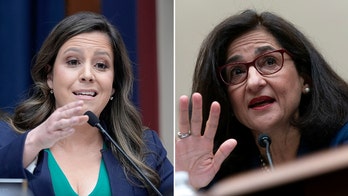
Oct. 8, 2013: A U.N. vehicle is seen near a photo of Syrian President Bashar al-Assad at the entrance of a hotel where a team of experts from the Organisation for the Prohibition of Chemical Weapons (OPCW) were staying in Damascus. (Reuters)
The Syrian regime of President Bashar al-Assad is still holding onto at least 12 chemical weapons production facilities it was supposed to destroy by June 30, and the Obama administration is supporting a proposal to obliterate initially only seven of them in the interests of a breakthrough deal.
The remaining five, apparently all underground facilities, must be dismantled, but the compromise would allow further negotiation over how that would take place, and how the destruction would be verified.
The U.S. position, hedged with stern warnings to the Syrians, was revealed this week in remarks by Robert Mikulak, the top American diplomat at a meeting of the executive council of the Organization for the Prohibition of Chemical Weapons (OPCW) in The Hague.
Mikulak said the deal was only available “this week” during the executive council’s session—but neither the State Department nor the OCPW answered questions from Fox News about whether any deal had been reached.
Even so, a spokesman for OPCW said there would likely be a “lapse of some days” before the records of the council meeting and its outcome would be revealed.
A number of other questions from Fox News about the nature of the facilities, and the compromise proposal first put forward by OPCW’s Technical Secretariat, were not answered by the State Department before this article was published.
According to Mikulak, “while this proposal requires serious compromises and is not entirely in keeping with the extraordinary decision this council took in September”—a reference to sweeping demands for the total destruction of Syria’s chemical weapons capability on a defined timetable—“the United States is prepared to support that compromise solution in the interests of reaching a council decision this week, as long as Syria also accepts it. We are not, however, prepared to go further or engage in further haggling.”
He added that if Syria “rejects this compromise proposal and continues its intransigence, there must be consequences. Syria cannot be allowed to stall every attempt at resolution and continue to defy its obligations and this council by indefinitely keeping its former CW production facilities.”
For all of Mikulak’s tough talk, however the regime has done pretty well so far at both stalling and avoiding drastic consequences for its inaction—and not only involving CW production facilities.
Haggling, delay, prevarication and dissembling have been the Syrian hallmark of the drawn-out weapons disposal discussions at all stages, as Mikulak also made clear in his statement. The much heralded destruction of Syria’s declared chemical weapons, which climaxed in a final hand-off last June, was intended to formally comply with a June 30 deadline for the turnover and demolition of all of Syria’s arsenal and facilities set in the OPCW council’s “extraordinary” September decision.
Even while the chemicals—or at least those the Assad regime has official owned up to -- were handed over in time, their destruction did not meet the deadline, and the demolition is likely to continue for months more.
On July 7, for example, the destruction began of some 600 tons of Syrian chemicals aboard a U.S. cargo ship in the Mediterranean; the Pentagon said the process might take about 60 days. Other facilities in Finland working on chemicals destruction had eliminated 11 tons of materials by June 26 but might take 150 days to accomplish their remaining work, according to an OPCW report.
Additionally, as Mikulak pointed out, “Syria has failed to engender international confidence that its declaration [of its chemical stockpile] is fully accurate and complete,” and, as he concluded, “the specter of CW use by the Assad regime continues to threaten the Syrian people.”
Indeed, he added, “the United States remains deeply concerned with credible indications that Syria is again using chemical weapons, as it did last August and in prior incidents, this time reportedly involving chlorine and other chemicals in attacks against the opposition.”
His August reference was to attacks near Damascus that killed hundreds of civilians, led President Obama to invoke his notorious “red line” on Syrian behavior, and the sudden compromise that led to the drawn-out weapons destruction process.
CLICK HERE FOR MIKULAK’S REMARKS
The problem is that the 45-member council includes as members both Russia and Iran, chief supporters of the Assad regime, and its decisions are made through a drawn out process of consensus, giving Assad ample room for a myriad dodges and delays.
All the more so in the case of the chemical weapons facilities, which include seven above-ground facilities and the five lodged in underground bunkers. According to OPCW reports, Syria was supposed to carry out the “functional destruction of chemical weapons production and mixing/filling equipment” in its facilities by November 1, 2013, and OPCW says “this objective was achieved by the target date.”
Ever since, however, the Assad regime has been haggling with the executive council over when the final destruction of the plants themselves should take place—if ever—and what constitutes their complete destruction, as well as procedures for ensuring that the destruction actually took place.
An OPCW team was dispatched to Syria last March and apparently came back with a plan. But the council thereafter decided only to encourage “all parties concerned to continue their consultations with a view to arriving at an agreement”—an invitation, in other words, to keep talking.
George Russell is editor-at-large of Fox News and can be found on Twitter @GeorgeRussell




